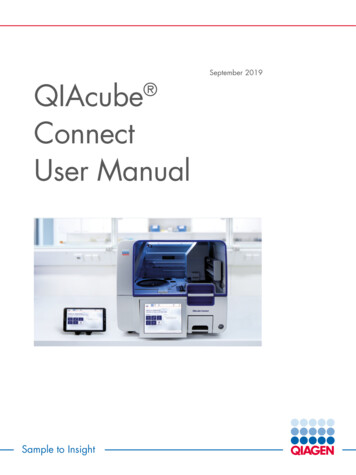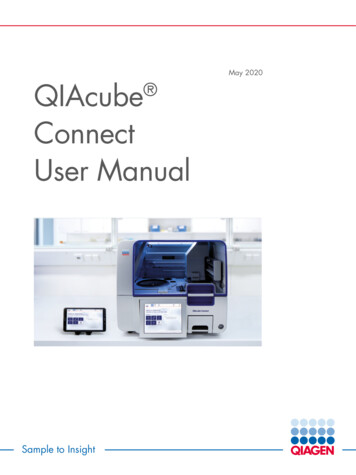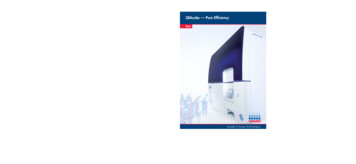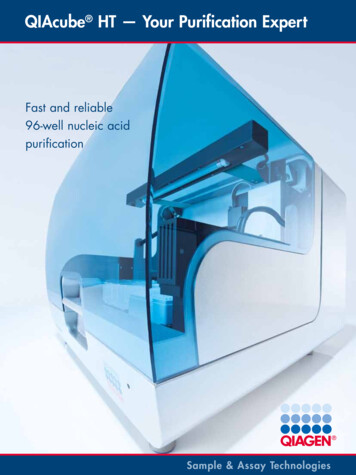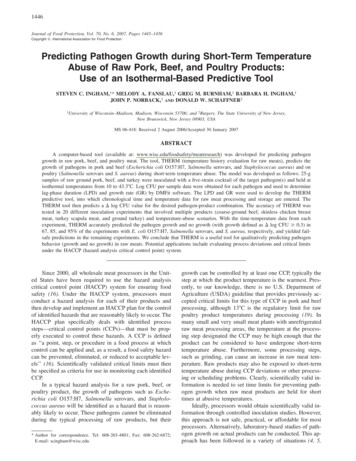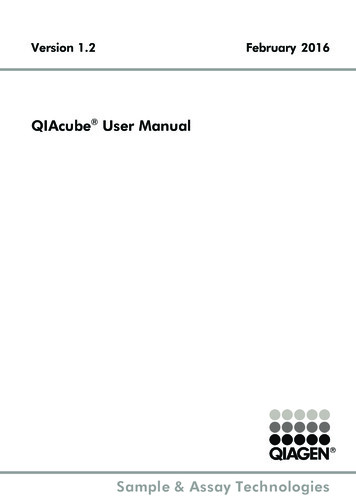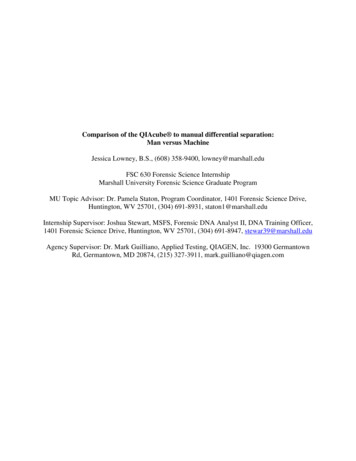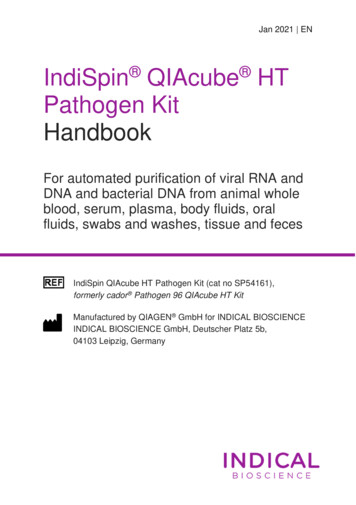
Transcription
Jan 2021 ENIndiSpin QIAcube HTPathogen KitHandbookFor automated purification of viral RNA andDNA and bacterial DNA from animal wholeblood, serum, plasma, body fluids, oralfluids, swabs and washes, tissue and fecesIndiSpin QIAcube HT Pathogen Kit (cat no SP54161),formerly cador Pathogen 96 QIAcube HT KitManufactured by QIAGEN GmbH for INDICAL BIOSCIENCEINDICAL BIOSCIENCE GmbH, Deutscher Platz 5b,04103 Leipzig, Germany
ContentsKit contents . 4Storage . 5Intended use . 5Symbols . 6Safety information . 6Quality control . 7Introduction . 8Principle and procedure . 8Nucleic acid purification protocol . 9Pretreatments . 11Equipment and reagents to be supplied by user . 13Important notes . 14Starting material . 14Yields of nucleic acids . 17Using Carrier RNA and internal controls . 17Storing nucleic acids . 18Handling RNA . 19Preparing reagents . 19Assembling the vacuum chamber . 23Optional features . 25Processing fewer than 96 samples per run . 25Off-board lysis . 25Manual lysis procedure . 26Protocol for use with QIAcube HT 4.17 software. 27Important points before starting . 272IndiSpin QIAcube HT Pathogen Kit Handbook 01/2021
Things to do before starting . 27Procedure . 29Cleaning the instrument after completing a run . 30Protocol for use with QIAcube HT Prep Manager software . 31Important points before starting . 31Things to do before starting . 31Procedure . 33Cleaning the instrument after completing a run . 34Optional steps . 35Troubleshooting guide . 40Order information . 43Change index . 44IndiSpin QIAcube HT Pathogen Kit Handbook 01/20213
Kit contentsIndiSpin QIAcube HT Pathogen KitCat. no.(480)SP54161Number of preps480IndiSpin 96 Plate51Buffer VXL3 x 30 mlBuffer ACB (concentrate)1,22 x 60 mlProteinase K2 x 6 mlCarrier RNA (poly A)2 x 310 µgBuffer AW1 (concentrate)1,32 x 98 mlBuffer AW2 (concentrate)32 x 66 mlBuffer AVE2 x 125 mlTopElute Fluid1 x 60 mlQuick-Start Protocol (PCard)21 CAUTION: Contains a chaotropic salt. Take appropriate laboratory safety measuresand wear gloves when handling. Not compatible with disinfectants containing bleach. Seepage 5 for safety information.2 Before using for the first time, add isopropanol as indicated on the bottle to obtain aworking solution.3 Before using for the first time, add ethanol (96-100%) as indicated on the bottle toobtain a working solution.4IndiSpin QIAcube HT Pathogen Kit Handbook 01/2021
StorageIndiSpin 96 plates and buffers can be stored dry at room temperature(15-25ºC) until the expiration date stated on the kit box without affectingperformance.Lyophilized Carrier RNA can be stored at room temperature until theexpiration date stated on the kit box. For use, lyophilized Carrier RNAshould be dissolved in Buffer AVE and then added to Buffer VXL, asdescribed in “Preparing reagents”, on page 19. This Carrier RNA/BufferAVE/Buffer VXL mix solution should be prepared fresh and is stable atroom temperature for up to 48 hours. Unused Carrier RNA dissolved inBuffer AVE should be immediately frozen in aliquots at -30 to -15 C. Donot subject aliquots of Carrier RNA to more than 3 freeze-thaw cycles.Proteinase K can be stored at room temperature (15-25 C). To store forextended periods of time, or if the ambient temperature often exceeds25 C, we recommend storing at 2-8 C.Intended useThe IndiSpin QIAcube HT Pathogen Kit is intended for the extraction ofpathogen nucleic acids (viral RNA and DNA, and bacterial DNA) fromanimal whole blood, serum, plasma, body fluids, oral fluids, swabs,washes, tissue (homogenate), and feces.For molecular biology applications.IndiSpin QIAcube HT Pathogen Kit Handbook 01/20215
SymbolsLegal manufacturerLot numberUse by dateTemperature limitations for storageHandbookCatalog numberMaterial numberSafety informationWhen working with chemicals, always wear a suitable lab coat,disposable gloves and protective goggles. For more information, pleaseconsult the appropriate safety data sheets (SDSs). These are availablefrom your local sales representative or by Email request undercompliance@indical.com.CAUTION: DO NOT add bleach or acidic solutionsdirectly to the sample preparation waste.6IndiSpin QIAcube HT Pathogen Kit Handbook 01/2021
Buffer VXL and Buffer AW1 contain guanidine hydrochloride, and BufferACB contains guanidine thiocyanate, which can form highly reactivecompounds if combined with bleach.If liquid containing these buffers is spilled, clean with suitable laboratorydetergent and water. If the spilled liquid contains potentially infectiousagents, clean the affected area first with laboratory detergent andwater, and then with 1% (v/v) sodium hypochlorite.Quality controlIn accordance with INDICAL’s ISO-certified Quality ManagementSystem, each lot of IndiSpin QIAcube HT Pathogen Kit is tested againstpredetermined specifications to ensure consistent product quality.IndiSpin QIAcube HT Pathogen Kit Handbook 01/20217
IntroductionThe IndiSpin QIAcube HT Pathogen Kit enables the efficient purificationof viral RNA and DNA, as well as bacterial DNA, from a broad range ofanimal sample types, including whole blood, serum, plasma, swabs,washes, tissue, and feces (see “Starting material” on page 14). Theextracted nucleic acids are free of proteins, nucleases, and otherimpurities, and are ready for use in downstream applications, such asreal-time PCR-based pathogen identification.However, specific combinations of sample types and pathogens shouldbe validated by the user.The kit is not intended for host RNA or host DNA preparation.Principle and procedureSamples are lysed under highly denaturing conditions at roomtemperature (15-25 C) in the presence of Proteinase K and Buffer VXL,which together ensure the inactivation of nucleases. Adding Buffer ACBadjusts the binding conditions for the copurification of DNA and RNA.The lysate is then transferred to an IndiSpin 96 Plate and coated withethanol. During vacuum, nucleic acids are adsorbed onto the silicamembranes while contaminants pass through. Three efficient washsteps remove the remaining contaminants and enzyme inhibitors, andnucleic acids are eluted in Buffer AVE.Performance is not guaranteed for every combination of startingmaterial and pathogen species and must be validated by the user.Some samples may require a pretreatment (see Table 1, page 10).8IndiSpin QIAcube HT Pathogen Kit Handbook 01/2021
Nucleic acid purification protocolThis handbook contains two protocols describing the purification ofpathogen nucleic acids from different sample types: For use with QIAcube HT 4.17 software (starting page 27).For use with QIAcube HT Prep Manager (starting page 31).The purification of pathogen nucleic acids is optimized for purification ofviral RNA and DNA, and the DNA of easy-to-lyse bacteria from up to200 μl of fluid material. Suitable starting materials for direct processingusing this method include: whole bloodserumplasmaoral fluidbody cavity fluids (e.g., peritoneal, synovial, cerebrospinal)liquid extracts from swabs (e.g., nasal, pharyngeal, andcloacal* swabs)wash fluids (e.g., from bronchoalveolar lavages)other fluids, such as urine or feces suspensions*Most sample types can be directly processed without pretreatment.However, depending on the starting material and the target pathogen,one of the pretreatment protocols may be needed. For samples thatrequire a pretreatment prior to nucleic acid purification, Table 1 onpage 11 provides an overview of which pretreatment protocols aresuited to different starting material and pathogen combinations.* The processing of samples with a high inhibitor content, such as urine and feces, may require areduction in sample input volume or further measurements. For further pretreatmentrecommendations, contact INDICAL support (support@indical.com).IndiSpin QIAcube HT Pathogen Kit Handbook 01/20219
The lysis and binding solutions used in the procedure are Buffer VXLand Buffer ACB. Please pay attention to the information given under“Safety information”, page 6.10IndiSpin QIAcube HT Pathogen Kit Handbook 01/2021
PretreatmentsThe pretreatments mentioned in this handbook are optimized forspecific combinations of starting material and target pathogens.The choice of pretreatment depends on the workflow focus and is to befollowed by nucleic acid purification.Table 1 on page 11 summarizes the pretreatments and theirapplications.Some of the pretreatments may require additional components, whichare indicated in each pretreatment protocol.Table 1: Overview of available pretreatment g., whole blood,serum, plasma,swab or washfluid, pretreatedtissue)Viral RNA andDNA, DNA ofeasy-to-lysebacteria1--Whole blood orpretreated tissueDNA of difficultto-lyse bacteria1Pretreatment B1for difficult-to-lyse bacteria inwhole blood or pretreatedtissueHB-2533Serum, plasma,swabs, washes,body cavity fluids,urineDNA of difficultto-lyse bacteria1Pretreatment B2for difficult-to-lyse bacteria inbody fluids2HB-2534High volume cellfree fluids (forincreasedsensitivity)DNA of easy-tolyse bacteria1Pretreatment B3for difficult-to-lyse bacteria inbody fluids2HB-2549IndiSpin QIAcube HT Pathogen Kit Handbook 01/202111
Tissue(e.g., liver, spleen,kidney, lymphnode)Pathogennucleic acidsPretreatment T1Mechanical disruption oftissueHB-2535Viral DNA3,bacterial DNA4Pretreatment T2Enzymatic digestion of tissueHB-2536Rapid PartialDisruption oftissueViral RNA andDNA,DNA of easy-tolyse bacteria1Pretreatment T3HB-2537Tissue containinghigh amount oflipids and/ornucleases (e.g.brain, pancreas)Viral RNA andDNA,DNA of easy-tolyse bacteria1Pretreatment T4HB-2538FecesViral RNA andDNAPretreatment F1Non-lysing suspensionmethodHB-2513Bacterial DNA1and viral DNAPretreatment F2Lysing suspension methodHB-2514Mycobacterium Pretreatment F-MAPavium subsp.paratuberculosis(MAP) DNAHB-2503Filter paper cardsPretreatment C1HB-2520Swabs (tracheal,oropharyngeal,blood)Pretreatment S1HB-2516Oral fluidsPretreatment O1HB-25511 Gram-positive bacteria are difficult to lyse due to their rigid cell wall. Many Gramnegative bacteria are easy to lyse, but some are not and will also benefit fromPretreatment B1 or B2.2 Not suitable for whole blood.3 Not suitable for viral RNA as the lysis conditions do not sufficiently conserve RNAintegrity.4 For difficult-to-lyse bacteria, subsequently use Pretreatment B1.For further information on Pretreatments websitewww.indical.com/handbooks contact INDICAL Support atsupport@indical.com.12IndiSpin QIAcube HT Pathogen Kit Handbook 01/2021
Equipment and reagents to be supplied byuserWhen working with chemicals, always wear a suitable lab coat,disposable gloves and protective goggles. For more information,consult the appropriate safety data sheets (SDSs), available from theproduct supplier. Pipettors and disposable pipette tips with aerosol barriers(20-1000 μl) Ethanol (96-100%)* Isopropanol Phosphate-buffered saline (PBS), may be required for dilutingsamples Vortexer QIAcube HT instrument QIAcube HT Plasticware QIAcube HT 4.17 Software or QIAcube HT Prep Manager Software QIAcube HT Reagent troughs* Do not use denatured alcohol, which contains other substances such as methanol ormethylethylketone.IndiSpin QIAcube HT Pathogen Kit Handbook 01/202113
Important notesStarting materialDo not overload the IndiSpin 96 Plate, as this can lead to impairednucleic acid extraction and/or performance in downstream assays. Forsamples with very high host nucleic acid contents (e.g., for certaintissues, such as spleen or blood samples with highly increased cellcounts), use less than the maximum amount of sample recommendedin the protocol or pretreatments. In some downstream applications suchas PCR and RT-PCR, very high background concentrations of nucleicacids may impair the reaction. Use appropriate controls (e.g., aninternal control) to verify successful PCR amplification.Avoid transferring solid material to the S-Block as this can reduce flowthrough the membrane (e.g., blood clots, solid tissue, swab fibers).When working with difficult samples, use a vacuum performance checkto check if all liquid has passed the membrane.Highly viscous fluids may require treatment to reduce their viscosity, toallow for efficient extraction of pathogen nucleic acids. Please contactINDICAL support at support@indical.com for recommendations.Avoid repeated thawing and freezing of samples, since this may reducenucleic acid yield and quality.Animal whole bloodBlood samples treated with EDTA, citrate, or heparin as anticoagulantcan be used for nucleic acid purification. Samples can be either fresh orfrozen, provided that they have not been freeze-thawed more thanonce. Freeze-thawing more than once can lead to denaturation and14IndiSpin QIAcube HT Pathogen Kit Handbook 01/2021
precipitation of proteins, resulting in potential reduction in viral titers,and therefore, reduced yields of viral nucleic acids.After collection and centrifugation, whole blood samples can be storedat 2-8ºC for up to 6 hours. For longer storage, we recommend freezingaliquots at -30 to -15ºC or at -70ºC.We recommend using 50-200 μl blood containing non-nucleatederythrocytes. However, highly elevated cell counts due to inflammatoryor neoplastic diseases may strongly increase the host nucleic acidcontent of a sample. In this case, reduction of sample input to 50 μlmay improve results in downstream assays, particularly in RT-PCR.If using less than 200 μl blood, adjust the sample volume to 200 μl withPBS or 0.9% NaCl.For blood samples containing nucleated erythrocytes (e.g., samplesfrom bird and fish), use less than 50 μl blood and adjust the samplevolume to 200 μl with PBS or 0.9% NaCl.Animal serum, plasma, other body fluids, swabs, oral fluids, and washspecimensFrozen plasma or serum must not be thawed more than once beforeprocessing.We recommend storing swabs in transport media; for example, viraltransport media (VTM) or brain-heart infusion broth (BHI). Remove theswab and squeeze out the liquid by pressing the swab against theinside of the storage tube. For extraction of viral RNA or DNA, werecommend centrifuging the swab media briefly to ensure any residualsolid materials are removed.Note: Solid pieces remaining in the sample fluid may aggregate on theIndiSpin 96 Plate membrane, which may decrease nucleic acid yield.IndiSpin QIAcube HT Pathogen Kit Handbook 01/202115
Up to 200 μl serum, plasma, other body fluid, swab media supernatant,or wash fluid can be processed.Carrier RNA must be used in the nucleic acid purification protocol toprevent the loss of nucleic acids during the procedure (see page 17 forinformation on the use of Carrier RNA).The processing of samples with very high inhibitor contents, such asurine or fecal suspensions, may require a reduction in sample inputvolume and/ or an extra pretreatment to remove inhibitors. To reducethe input volume, use 25-50 μl of the sample and adjust the volume to200 μl with PBS or 0.9% NaCl.For extraction of bacterial DNA, the input volume can be increased tomore than 200 μl, e.g., 1.5 ml for increased sensitivity of bacterialdetection. Gram-negative bacteria in cell-free fluids can beconcentrated by centrifugation of higher volumes. Resuspend pellets inPBS and use 200 μl as starting volume. See Pretreatment B2 forextraction of DNA from difficult-to-lyse bacteria.Animal tissuesWhen working with tissue samples, mechanical or enzymatic disruptionof the tissue structure is the prerequisite for liberation of cells,subsequent release of nucleic acids, and membrane permeability of thematerial.Different tissue types can vary widely with regard to texture and rigidity,cell types, and content of host nucleic acids and inhibitory substances.In addition, the localization of pathogen nucleic acids in the tissue mayvary depending on tissue type, pathogen, and stage of infection.Therefore, suitability of the pretreatment protocols in this handbookshould be evaluated for each new combination of tissue and pathogen.Additional pretreatments for tissue samples are available at INDICALSupport, including a rapid protocol and recommendations for difficulttissues.16IndiSpin QIAcube HT Pathogen Kit Handbook 01/2021
Up to 25 mg of fresh or frozen tissue can be used as a starting amount.For tissues with a very high number of cells for a given mass of tissue,such as spleen, a reduced amount of starting material (5-10 mg) shouldbe used.Using too much input material decreases the quality and the amount ofDNA and leads to an increased risk of blocked membranes.Yields of nucleic acidsFor samples containing a low amount of cells (e.g., serum and plasma),the yield of viral nucleic acids obtained can be below 1 μg and istherefore difficult to quantify using a spectrophotometer. In addition,eluates prepared with Carrier RNA may contain much more CarrierRNA than target nucleic acids. The IndiSpin QIAcube HT Pathogen Kitrecovers total nucleic acids. Therefore, cellular DNA and RNA will beco-purified from any cells in the sample along with viral RNA and DNA,and bacterial DNA, and cannot be distinguished usingspectrophotometric measurements. We recommend using quantitativeamplification methods such as quantitative real-time PCR or real-timeRT-PCR to determine pathogen nucleic acid yields.Using Carrier RNA and internal controlsCarrier RNAWe recommend adding Carrier RNA to fluids containing low amounts ofcells such as serum, plasma, swab media, and wash fluid.This enhances adsorption of viral RNA and DNA to the silicamembranes, which is especially important when the target moleculesare not abundant. In addition, an excess of Carrier RNA reduces thechances of viral RNA degradation in the rare event that RNases are notdenatured by the chaotropic salts and detergents in the lysis buffer. NotIndiSpin QIAcube HT Pathogen Kit Handbook 01/202117
using Carrier RNA may decrease the recovery of viral nucleic acids. Donot add Carrier RNA to whole blood and tissue samples, or othersamples containing a high amount of cells.Internal ControlUse of an internal control, such as the intype IC-DNA or intype IC-RNAis optional, depending on the amplification system of choice. If theIndiSpin QIAcube HT Pathogen Kit is used in combination withamplification systems that employ an internal control, introduction ofthese internal controls may be required during the purificationprocedure, to monitor the efficiency of sample preparation anddownstream assay.Add unprotected internal control nucleic acids (e.g., plasmid DNA or invitro transcribed RNA) to VXL mixture only. Do not add these internalcontrol nucleic acids directly to the sample.The amount of internal control added depends on the assay systemand the elution volume. Evaluation of the correct amount of internalcontrol nucleic acid must be performed by the user. Refer to themanufacturer’s instructions to determine the optimal concentration ofinternal control or contact INDICAL Support (support@indical.com) forfurther information.Storing nucleic acidsFor short-term storage of up to 24 hours, we recommend storing thepurified viral RNA and DNA at 2-8 C. For storage longer than 24 hours,we recommend storing purified nucleic acids at -30 to -15 C, or even at-70 C in the case of RNA.18IndiSpin QIAcube HT Pathogen Kit Handbook 01/2021
Handling RNARNases are very stable and active enzymes that generally do notrequire cofactors to function. Since RNases are difficult to inactivateand only minute amounts are sufficient to destroy RNA, do not use anyplasticware or glassware without first eliminating possible RNasecontamination. Care should be taken to avoid inadvertently introducingRNases into the RNA sample during or after the purification procedure.Preparing reagentsCarrier RNA stock solutionFor use, lyophilized Carrier RNA should first be dissolved in BufferAVE. Add 310 μl Buffer AVE to the tube containing 310 μg lyophilizedCarrier RNA to obtain a stock solution of 1 μg/μl. Add this solution toBuffer VXL mixture as in Table 2 on page 28 or Table 3 page 32.Unused Carrier RNA dissolved in Buffer AVE should be frozen inaliquots at -30 to -15 C. Aliquots of Carrier RNA should not besubjected to more than 3 freeze-thaw cycles.Adding Carrier RNA to Buffer VXLWe recommend adding Carrier RNA to fluids containing a low amountof cells such as serum, plasma, swabs media, and wash fluid. Do notadd Carrier RNA to samples with a high cell content such as wholeblood and tissue because high amounts of background nucleic acidsmay negatively influence downstream applications such as RT-PCR.Carrier RNA dissolved in Buffer AVE is added to Buffer VXL so that1 μg carrier RNA is present in each sample.IndiSpin QIAcube HT Pathogen Kit Handbook 01/202119
Note: 100 μl of Buffer VXL containing dissolved Carrier RNA is usedper preparation.Important note: Carrier RNA does not dissolve in Buffer VXL. It mustfirst be dissolved in Buffer AVE.The Buffer VXL solution containing dissolved Carrier RNA should beprepared fresh and is stable at room temperature (15-25ºC) for up to 48hours.Proteinase KThe IndiSpin QIAcube HT Pathogen Kit contains ready-to-useProteinase K supplied in a specially formulated storage buffer. Theactivity of the Proteinase K solution is 600 mAU/ml.Proteinase K is stable for at least 1 year after delivery when stored atroom temperature (15-25 C). To store for more than 1 year or ifambient temperature often exceeds 25 C, we recommend storingProteinase K at 2-8 C.Add Proteinase K to Buffer VXL immediately before starting theprotocol.Buffer ACBBuffer ACB is supplied as a concentrate. Before using for the first time,add Isopropanol (100%) as indicated on the bottle. Tick the check boxon the bottle label to indicate that Isopropanol has been added. Mix wellafter adding Isopropanol.20IndiSpin QIAcube HT Pathogen Kit Handbook 01/2021
Buffer AW1Buffer AW1 is supplied as a concentrate. Before using for the first time,add Ethanol (96-100%) as indicated on the bottle. Tick the check boxon the bottle label to indicate that ethanol has been added.Reconstituted Buffer AW1 can be stored at room temperature(15-25 C) for up to 1 year. Mix well after adding Ethanol.Buffer AW2Buffer AW2 is supplied as a concentrate. Before using for the first timeadd Ethanol (96-100%) as indicated on the bottle. Tick the check boxon the bottle label to indicate that ethanol has been added. Mix wellafter adding Ethanol.Handling Buffer AVEBuffer AVE is RNase-free upon delivery. It contains sodium azide, anantimicrobial agent that prevents growth of RNase-producingorganisms. However, as this buffer does not contain any RNasedegrading chemicals, it will not actively inhibit RNases introduced byinappropriate handling. When handling Buffer AVE, take extreme careto avoid contamination with RNases. Follow general precautions forworking with RNA, such as frequent change of gloves and keepingtubes closed whenever possible.TopElute FluidTopElute Fluid is used during elution of nucleic acids from the IndiSpin96 Plate membrane. It enables application of a stable and high vacuumand results in equal eluate volumes. In addition, TopElute Fluideliminates the formation of drops of elution buffer at the outlet nozzlesof the IndiSpin 96 Plate.IndiSpin QIAcube HT Pathogen Kit Handbook 01/202121
TopElute Fluid might be found as a top layer over the elution buffer. It isinert and has no effects on downstream applications.Important: Please ensure that you only take the eluate from below thetop layer.22IndiSpin QIAcube HT Pathogen Kit Handbook 01/2021
Assembling the vacuum chamberFigure 1 on page 24 illustrates the assembly of the vacuum chamber.For further information, please refer to the QIAcube HT User Manual.1. Insert the channeling block holder into the left (waste) chamber ofthe vacuum chamber.2. Press firmly on the sides of the channeling block holder to seat it inthe chamber, sealing the O-ring on the spigot into the drain.3. Then, place the channeling block into the channeling block holder.4. Place the IndiSpin 96 plate in the transfer carriage. Load thecarriage with the IndiSpin 96 plate into the left (waste) chamber ofthe vacuum chamber.5. Ensure that the carriage is positioned to the left inside the vacuumchamber. Place the riser block EMTR in the right (elution) chamberof the vacuum chamber with the pin of the riser block EMTR in thetop right position.6. Load an elution microtubes rack (EMTR) into the elution chamber.IndiSpin QIAcube HT Pathogen Kit Handbook 01/202123
IndiSpin 96 plateTransfer carriage(cat. no. 9022654,QIAGEN)Channeling adapter(cat. no. 9022656,QIAGEN)Elution microtubes(EMTR)Contains:Channeling block(cat. no. 9022665,QIAGEN)Riser-block holderEMTR(cat. no. 9022655,QIAGEN)Channeling-blockholder(cat. no. 9022664,QIAGEN)Vacuum chamberFigure 1: Assembling the vacuum chamber24IndiSpin QIAcube HT Pathogen Kit Handbook 01/2021
Optional featuresProcessing fewer than 96 samples per runIf processing fewer than 96 samples reuse of IndiSpin 96 plates,S-Block and EMTR is possible up to three times.Note: We recommend using fresh plasticware for every run. If reusing,take extreme care to prevent cross-contamination. Store plates in a way that separates the outlet nozzles under theplate, for example, in the S-Block used in the same run or in a fresh96-well microtiter plate. Cover unused wells of the S-Block and IndiSpin 96 plate with a tapesheet at all times. Remove unused Elution Microtubes from the EMTR in rows of eighttubes.Off-board lysisFor some applications, it may be necessary to lyse samples in a safetycabinet. For some sample types, a heated lysis outside the instrumentmight enhance performance.If lysis with Proteinase K is carried out off-board, Proteinase K may beexchanged with water when setting up the worktable.QIAcube HT 4.17 SoftwareA protocol allowing for lysis outside the instrument is available from ourtechnical support team.QIAcube HT Prep Manager SoftwareWhen using an off-board lysis protocol, choose the cador pathogenIndiSpin QIAcube HT Pathogen Kit Handbook 01/202125
heated off-board lysis protocol in the software setup step under theselected protocol.Manual lysis procedureFollow this procedure for manual sample lysis if using the cadorpathogen heated off-board lysis protocol.1. Add 200 µl of each fluid sample to the bottom of an S-Block well.2. Cover the S-Block with adhesive tape.3. Incubate at 70 C, with constant agitation, for 10–15 min.4. Optional: Briefly centrifuge the S-block to remove liquid from theinside of the tape.5. Remove the adhesive tape from the S-Block.6. Proceed with the “cador pathogen protocol on the QIAcube HT”,using either the QIAcube HT 4.17 software (page 27) or theQIAcube HT Prep Manager software (page 31).26IndiSpin QIAcube HT Pathogen Kit Handbook 01/2021
Protocol for use with QIAcube HT 4.17softwareThis protocol is for the purification of viral RNA and DNA, and the DNAof easy-to-lyse bacteria from fluid samples or pretreated tissuesamples.Important points before starting Before beginning the procedure, read “Important notes” (page 14). Do not overload the IndiSpin membranes as this can lead toimpaired nucleic acid extraction and / or performance in downstreamapplications. Avoid repeated freezing and thawing of samples as this may reducenucleic acid yield and quality.Things to do before starting If necessary, thaw and equilibrate samples at room temperature(15-25 C). Check for
IndiSpin QIAcube HT Pathogen Kit Handbook 01/2021 9 . Nucleic acid purification protocol . This handbook contains two protocols describing the purification of pathogen nucleic acids from different sample types: For use with QIAcube HT 4.17 software (starting page 27). For use with QIAcube HT Prep Manager (starting page 31).

